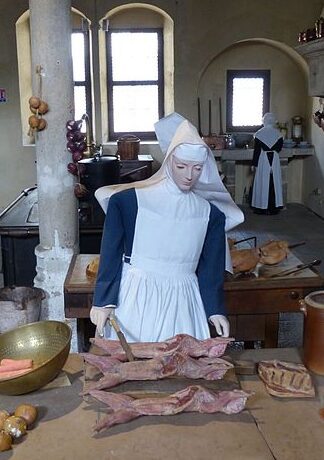Howard Fischer
Uppsala, Sweden
 |
| Kitchen – Hotel Dieu, Beaune. A model of a nun preparing rabbit. Crop of photo by Elekes Andor. May 17, 2016. Via Wikimedia. CC BY-SA 4.0. |
“Jack Sprat could eat no fat,
his wife could eat no lean…“
— Sixteenth-century nursery rhyme
Rabbit starvation (fat starvation, mal de caribou, protein poisoning) is an acute type of malnutrition that develops from a diet deficient in fat and where nearly all calories come from lean meat. Rabbit meat is very lean, as can be elk or caribou (reindeer) meat at certain times of the year. Charles Darwin (1809-1882), in The Voyage of the Beagle (1839), quotes arctic explorer Dr. Sir John Richardson (1787-1865): “When people for a long period eat only lean meat, they develop an insatiable desire for fat, and they can eat a large quantity of pure fat without nausea.”1 If fat is not available, an individual develops fatigue and nausea within a few days, diarrhea in seven to ten days, and dies after several weeks.2 Darwin also noted that the “gaucho on the pampas” for months at a time ate only beef, but much fat along with the meat.3
Vilhjalmur Stefánsson (1879-1962), a Canadian explorer and anthropologist, spent years living among indigenous peoples of the Canadian North. He wrote, “[They] seem to me to be the healthiest people I ever lived with,”4 consuming a diet high in protein and fat, no agricultural or dairy products, and few carbohydrates.5
The explanation for the difference that fat makes is found in the liver. The human liver can metabolize 285-365g of protein per day, about 2g per kg of body weight. The kidneys have a limited capacity to eliminate the products of protein catabolism. When the liver’s capacity to metabolize protein or the kidney’s capacity to eliminate waste products is exceeded, we develop excessive amounts of amino acids, ammonia, and urea in the blood stream. This metabolic chaos is, quite simply, a type of poisoning.
An average daily caloric intake of about 2000 kcal would necessitate ingesting 500g of protein (since one g of protein furnishes four kcal) in the absence of other caloric sources. This is, again, protein poisoning.6 The addition of fat to this high protein diet allows for another source of calories and a diminished intake or metabolism of protein. Under normal circumstances, 10 – 20% of our calories should come from protein. In rabbit starvation, about 45% comes from protein.
Stefánsson tells us that the Inuits of Northern Canada preferentially hunted older male ruminants like elk and caribou. These animals have a large slab of back fat, weighing twenty to twenty-five kg.7 There is also fat around the kidneys, in the bone marrow, and behind the eyes.8 The Indians of the Great Plains hunted buffalo and often removed only the fatty portions of the animal, if there were any.9 In Africa it was shown that fifteen species of wild herbivores had a body fat content of about 4%. Domestic cattle have a body fat content of at least 30%.10 When the majority of the Pitjantjatara people of Central Australia were hunter-gatherers, they would examine the carcass of a freshly killed kangaroo in order to estimate the fat content. If it was not high enough, it was left to rot.11
Stefánsson wanted to show the harm of a lean-meat-only diet versus a meat-and-fat diet. His experiment was conducted in the metabolic unit of Bellevue Hospital in New York City, under the supervision of doctors from Cornell University Medical School. First, Stefánsson ate only a lean meat (high protein) diet. After three or four days, symptoms began, which were reversed by the ingestion of fat. In the second part of the experiment, which lasted one year, he ate meat, fish, poultry, fats, and organ meats (brain, liver). He remained healthy on this high-protein, high-fat diet. The US government recognized the validity of these findings in a booklet for airmen downed in jungle, desert, or arctic terrain:12 “Because of the importance of fats, under no circumstances limit yourself to a meat diet of rabbit.”
Man cannot live by rabbit alone.
References
- NA. “Darwin’s observations from ‘The voyage of the Beagle.’” ND. fr.wikipedia.org
- Nora Gedgaudas. The Fat of the Land. ND. rightsteptechnologies.com
- “Darwin’s obeservations.”
- Getgaudas. “The Fat.”
- Patricia Gadsby. “The Inuit paradox: How can people who gorge on fat and rarely see a vegetable be healthier than we are?” Discover, 25(10), 2004.
- NA. “Mal de caribou.” ND. wikimonde.com
- NA. ND. archive.wikiwix.com
- Gedgaudas. “The Fat.”
- Marvin Harris. “Meat Hunger,” In The Sacred Cow and the Abominable Pig. New York: Simon and Schuster, Inc, 1985.
- Harris. “Meat Hunger.”
- Harris. “Meat Hunger.”
- Flight Control Command Safety Education Division of the United States Army Air Force. Jungle, Desert, and Arctic Emergencies. 1941-1947.
HOWARD FISCHER, M.D., was a professor of pediatrics at Wayne State University School of Medicine, Detroit, Michigan. He has a pet rabbit.

Leave a Reply